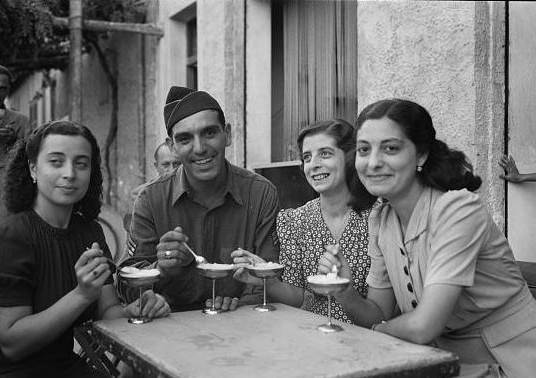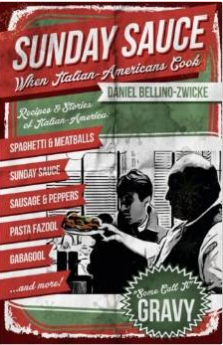
ITALIAN AMERICANS
FRANK SINATRA and Then GIRLFRIEND NANCY BARBATTO
Loyal Americans (1930-1945) – A second generation of Italian Americans begins to enter the labor movement, politics, sports and entertainment. Fiorello LaGuardia becomes mayor of New York City. Joe DiMaggio, the son of a San Francisco fisherman, becomes a baseball powerhouse who becomes an American hero. But with the outbreak of World War II, loyalty to America is questioned and Italians are forced to choose between two nations at war. While many Italian Americans fight on the frontlines with valor and bravery, other Italian Americans are labeled ‘Enemy Aliens,’ including DiMaggio’s parents. The war proves to be a turning point for Italian Americans as they begin to break out of their enclaves. The American Dream (1945-present) – In post-war America, Italian Americans enter the middle class. Italian-American crooners define American cool, but even as Frank Sinatra skyrockets to fame, he is haunted by accusations of Mafia ties. Can Italian Americans fit into 1950s America or will the specter of organized crime always plague them? Governor Mario Cuomo, son of Italian immigrants, struggles to straddle both worlds, while his sons’ success promises assimilation and acceptance. Antonin Scalia becomes the first Italian American appointed to the U.S. Supreme Court and Congresswoman Nancy Pelosi is the first woman and Italian American elected to Speaker of the House. Have Italian Americans finally shed the old stereotypes and become fully accepted in America?

The COPPOLA’S
AUGUST COPPOLA , TALIA , and FRANCIS FORD COPPOLA

A GI Who Found His ITALIAN COUSINS in PALERMO
1943
New York City Mayor Bill de Blasio is making a few special stops during his trip to Italy this summer. Some of these stops, such as meeting with Ignazio Marino, the mayor of Rome, he probably did not make when he first visited his maternal grandfather’s home town, Sant’agata de’ Goti, as a teenager in the 1970s. Bill de Blasio’s maternal grandfather, Giovanni de Blasio, immigrated to New York from a small town near Naples . While Giovanni was relatively comfortable financially, he left southern Italy with the same hope as many Southern Italians at that time: to make it in America.
One of the families who lived at 97 Orchard Street was the Baldizzi family. The Baldizzis were from Sicily and were part of a similar wave of immigration to that of the Giovanni de Blasio. The Italian experience of immigration to the United States was different for northern and for southern Italians. Northern Italians immigrated earlier to the U.S than their southern countrymen. By 1870 there were about 25,000 Italian immigrants, mostly northern Italians who were escaping political turmoil and the Risorgimento, the wars surrounding Italian independence and reunification. The wave of immigration from southern Italy and Sicily was affected by a variety of what historians call push factors: high taxes, scarcity of fertile farmland, and several natural disasters including tidal waves and eruptions from both Mt. Etna and Mt. Vesuvius. Giovanni de Blasio left Sant’Agata in 1905. In that same year, 7,849 citizens left that area.

Rossaria Baldizzi with Her GOD CHILD on the Day of Her HOLY COMMUNION
Aldopho Baldizzi was from Palermo, a Scilian town that also saw huge numbers of emigrants in the early years of the Twentieth Century. Aldolpho was a skilled carpenter. Despite his prowess, in Sicily he made only about $1.80 a week for his work and had heard rumors that carpenters in New York he could make closer to $18 a week. Aldopho had higher hopes for his young family. He was married to Rosaria Mutolo ,the daughter of the woman who sold him eggs. He left Sicily in 1923 without Rosaria. Traveling as a single young man was somewhat common among southern Italian immigrants because,unlike some of the Eastern European Jewish families who left their homes to escape persecution, some Italian immigrants held the possibility of return in case they found they could not make ends meet in the United States. Eventually, Aldolpho Baldizzi gained a foot-hold in New York and saved enough money for Rosaria to come join him. Many Italian immigrants did however return home. Between 1900 and 1910 40% of Italian immigrants returned to Italy – these immigrants were called the ritornati.

BUDDYS
FRANK & DEAN
Dino Croccetti and Francis Albert Sinatra
Italian immigrants also continued to send money, when they had it, home to families and villages in Italy. In 1896 a U.S. government commission estimated that Italians sent somewhere between $4 and $30 million annually back to Italy. Giovanni de Blasio sent chocolate and clothing back to Sant’Agata to be distributed by his brother, who was a priest. Giovanni also bought the first television in the town when he returned for a visit in 1953 and invited his neighbors to watch with him.

APERTIVO TIME

SUNDAY SAUCE
WHEN ITALIAN-AMERICANS COOK
by NEW YORK ITALIAN-AMERICAN AUTHOR
DANIEL BELLINO “Z”
.
.